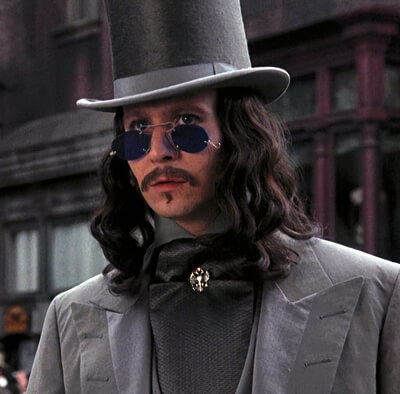History of the Vampire Myth
The legend of the vampire can be traced to approximately 125 AD, where a Upir, a creature with vampire qualities,
occurred in Greek mythology. The word Upir is found for the first time in written form in 1047 in a letter to the Russian Prince
Vladimir Yaroslavovich. The author of the letter, a priest, writes his name as
Upir' Likhyi, which roughly translates
into "Wicked Vampire" or "Foul Vampire". Upir later became vampire, and some of the early legends came from the far east.
Much has been lost throughout history...
The Oxford English Dictionary dates the first appearance of the word vampire in English to 1734. It was written in a travelogue
titled
Travels of Three English Gentlemen and was published in the Harleian Miscellany in 1745. Vampires had already been
discussed in German literature. After Austria gained control of northern Serbia and Oltenia in 1718, officials noted the local
practice of exhuming bodies and "killing vampires" (
Vampires, Burial and Death by Paul Barber). These reports,
prepared between 1725 and 1732, received widespread publicity. Vampires are similar to man in respect that no two are alike. No two men
have the same physical abilities, or the same senses of hearing or sight. This is true of vampires as well. As there are several races
of man, there are also many races of vampire.
Each race of vampire share similar, although not identical, abilities. Each race of vampire has different origins, unlike man.
An example of one race is the Kindred, as portrayed by
White Wolf. The
Kindred are then further subdivided into "clans." Other examples include the Carpathian race, of which Count Dracula, or Vlad Tsepesh
(or Tepes), was descended from.
Description and Appearance
It is difficult to make a single, definitive description of the folklore vampire. There are several elements common
to the many European legends. Vampires are usually reported as bloated in appearance, ruddy, purplish, or dark in color.
These characteristics were often attributed to the recent drinking of blood. Blood was often seen seeping from the
mouth and nose when one was seen in its shroud or coffin and its left eye was often open. A vampire was often clad in the linen
shroud it was buried in. Its teeth, hair, and nails may have grown somewhat, though in general, fangs were not a feature.
Other attributes varied greatly from culture to culture. Some vampires, such as those found in the Transylvanian tales, were gaunt,
pale, and had long fingernails. Vampires from Bulgaria only had one nostril. Bavarian vampires slept with thumbs
crossed and one eye open. Moravian vampires only attacked while naked. Albanian vampires wore high-heeled shoes.
As stories of vampires spread throughout the globe to the Americas and elsewhere, so did the varied and sometimes bizarre
descriptions of them. Mexican vampires had a bare skull instead of a head. Brazilian vampires had furry feet. Vampires from
the Rocky Mountains only sucked blood with their noses and from the victim's ears. Common attributes were sometimes described,
such as red hair. Some were reported to be able to transform into bats, rats, dogs, wolves, spiders and even moths.
The Vampire in Literature
Numerous vampire stories were written prior to the popularization of the vampire myth in pop culture.
The Vampyre; a Tale by John Polidori (1819)
A short story that exploited the gothic horror predilections of the public of the period. It was originally mis-published
under the authorship of Lord Byron (Polidori was Lord Byron's personal physician). The tale accounts the exploits of Lord Ruthven,
a British nobleman and vampire. Lord Ruthven bore more than a passing resemblance to Lord Byron and became a highly influential
model for the Byronic vampires of literature.
Varney The Vampire by James Malcolm Rymer (1845-47)
A Victorian-era gothic horror story which first appeared in a series of pamphlets between 1845 and 1847. Inexpensive and
gruesome, the collective work was published in book form in 1847. The tale runs 868 pages and is divided into 220 chapters. The story
revolves around the persecution of the Bannerworth family by Sir Francis Varney, a vampire who in the early chapters enters
the bedroom of the daughter of the house (Flora) and sucks her blood.
Carmilla by J. Sheridan Le Fanu (1872)
A compelling gothic novel of a lesbian vampire, set in darkest central Europe. It tells the story of a young woman's susceptibility
to the attentions of a female vampire named Carmilla. The story was to greatly influence Bram Stoker in the writing of Dracula.
It also served as the basis for several films, including Hammer's The Vampire Lovers (1970), Roger Vadim's Blood and Roses (1960),
and Danish director Carl Theodor Dreyer's Vampyr (1932).
Dracula by Bram Stoker (1897)
The most well known vampire story, the novel is mainly composed of journal entries, letters, and newspaper clippings. It has
been suggested that the story was based on Vlad Tepes, a medieval figure of extraordinary bloodthirst. History records that Vlad Tepes
impaled his enemies and cut off their heads. He ruled Walachia as Vlad III during the 15th century (modern day Romania) and signed
his letters as Vlad Dracula. Dracula translates into "son of the devil".
This document is not intended to be a comprehensive document of vampire fiction, mythology, or lore.









